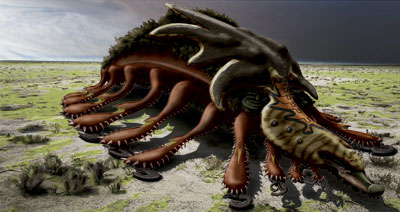
| |
| Skizan | |
|---|---|
| Universe | Source World Ghosts |
| Homeworld | Pladjia |
| Average Height | 2 meters long |
| Diet | Carnivore |
| Language | Pladjini |
| Sapience Level | Sapient |
| Subspecies | Soft-bodied and Shelled varieties |
From the Source World Ghosts series.
Reviled by Skizan and human alike, the Pladjin are famous for the destructive war they initiated against the Antiquarians. Lasting for four thousand years, the Pladjini assault on humanity was characterized by an unrelenting struggle between the two species, which ended in stalemate only when the Skizan intervened on the human side.
The origins of the Pladjin are not known, but they are assumed to lie in great numbers beyond the Eos, in a region of the galactic arm known as Pladjia. Though their source world remains a mystery, their penchant for invading human worlds and their ability to survive in human environments without articficial support suggests that they originate from a terrestrial-like planet.
Technologically, the Pladjin are believed to be slightly less sophisticated than humans or Skiza. No Pladjin vessel has ever been seen using Belemyolan colonies for shifting, for example. Likewise, it is assumed that their weaponry is also inferior, though without hardly any contact with the Pladjin in the past six thousand years, this assumption rests on little hard evidence.
Biology[]
The Pladjin are known to take at least two forms, either a sinuous, soft-bodied variety or one with a shell. Aside from this one difference, however, both types of Pladjin share the same basic morphology. Standing low to the ground on fourteen legs, Pladjin have an insect-like appearance. Their legs are spiked and are followed near the front of their bodies by six, smaller, similarly designed arms. Both their legs and arms have black, hook-like mandables at their ends. While the legs grow from a glossy body, often covered in thick black hair, their arms grow from their long, flexible snouts. At the end of these snouts are short trunks with a small mouth at the end. Pladjin have six, small black eyes, set in triplets on either side of the backs of their heads. Between the head and body are sack-like organs which function as nostrils and ears. The shelled variety of Pladjin carry a sturdy, boney armor on their backs which stretches from near the ends of their snouts to midway down the back. These shells are often painted to accent the eyes which stick out of holes along the head. Pladjin are known to vary in color from navy blue to dark red and brown.
History[]
Only mythology provides clues into where and when the first contact between humans and Pladjin occurred. According to the Epic of Sallandrin, a story with many versions, first contact with the Pladjin took place deep in the realm of the Eos, on a world called Deima. Faoist texts account for this world in many of their other stories, so that many scholars believe this world was an important one for followers of early Fao Su. The Epic tells how a plague never before encountered broke out across Deima, killing two-thirds of that world's inhabitants. Soon after, the survivors found their skies filled with sinister-looking craft of an intelligence not known. The hero of the epic, Sallandrin, is ultimately forced off-world to seek assistance from various neighboring worlds, where he assembles a force capable of liberating his people from the clutches of the alien power. In some versions, Sallandrin returns to find all his people exterminated and founds a new society after reconquering Deima.
However the first contact actually took place, the pattern of Pladjini conquest depicted in the Epic of Sallandrin is familiar to all historians of recorded encounters with the Pladjin. As is purported to have transpired on Deima, the early strategy of the Pladjin was to soften up its enemies through the use of biological agents let loose on human populations before striking with their fleets. Later, as the war turned from one of colonization to one of survival, the Pladjin turned to more destructive weapons, leaving whole planets bereft of life. Similarly, humans lost their appetite for fighting for territory and also undertook a strategy of extermination, striking into Pladjia. Thousands of years later, the great belt of dead worlds within the Eos was all that was left of the regions between the Nodal worlds and Pladjia.